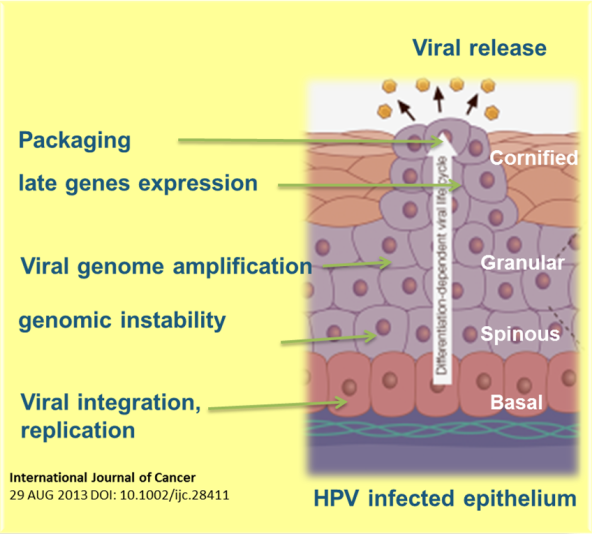
HPV infects the bottom-most layer of the skin or mucosa lining of the cervix, vagina, oral cavity , penis, anus or vulva. After infection, Viral DNA multiplies only in the middle layers and the cancer causing genes of the virus are switched on. The viral particles are later assembled and is transported to the body cavity through top most layer of the skin.
“HPV infection leads to one of three possibilities:
(i) Anogenital warts on or around the genitals and anus in both men and women.
These warts are generally associated with HPV6 and HPV11 and DO NOT lead to cancer. Most don’t have any particular symptoms and may spontaneously go away in 3 to 4 months, remain the same, or increase in size and number. Treatment options include ablation, excision, or topical agents such as 0.5% podophyllin (Podocon) or 5.0% imiquimod (Aldara). When anogenital warts are red-brown pigmented, they should be subjected to biopsy since they may actually be due to HPV16 or HPV18 .
(ii) Latent or inactive infection,
Very few people know they are actually infected due to absence of noticeable symptoms and the infected area remains fairly normal. HPV DNA is present in approximately 10% of women with cytologically normal cervical epithelium. The HPV DNA detected was primarily of low-risk HPV6, 11, and others.
(iii) Active infection,
Now this is the serious type. It’s associated with high-risk HPV types in which the virus causes changes in infected cells which may result in penile, urethral, bladder, vaginal, vulvar, or cervical cancer. Some High-risk HPV types include HPV9, 10, 15, 38, 42, 65, 66, 67, 68, 69, 70, 71, 72, 76, 79, 80, 82, 90, 91, 105, 122. In particular, the risk of progression of cancer is greater for two major types HPV16 and 18 (approximately 40%) than for other HPV types.”
(Clin Microbiol Rev. Jan 2003; 16(1): 1–17).